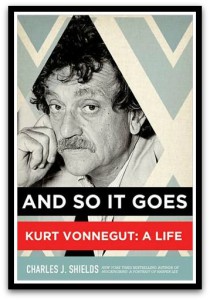Book Review: And So It Goes, Kurt Vonnegut: A Life

For those of us who love Kurt Vonnegut’s books, and the humanist persona that surrounds many of them, Charles Shields new biography “Kurt Vonnegut: A Life” is a bit of a jolt. The man Shields portrays does not necessarily live up to the philosophy of kindness and good feeling that permeates Vonnegut’s writing. However, it is nonetheless a solidly researched and written biography that gives due deference both to Mr. Vonnegut’s life and his place in literature.
Born into an upper-middle-class Indianapolis family, Vonnegut had a somewhat privileged upbringing but significantly not as privileged as his older siblings, as the family fortunes began to slide as Kurt entered his teenage years. Still he has taste of popularity and success in high school and goes off to Cornell to pursue a career in science, although one he is not especially enthusiastic about. At college he finds his true calling seems in newspapers and writing which he pursues more enthusiastically than his academic studies. In fact, rather than fail chemistry courses he drops out of Cornell, and rather than wait to be drafted he enlists in the U.S. Army.
This, of course, leads to the defining event of his life, being taken as a prisoner of war and being held in a German prison camp at the time of the horrific bombing of Dresden, Germany in 1945. His actual experience of the direct bombing was shielded by being held prisoner in an underground (and therefore relatively safe) animal processing warehouse—“Slaughterhouse Five” as it was known. His real experience of the bombing was with its aftermath, being brought up from the slaughterhouse to see the destruction, and being assigned to work over the next days and weeks to teams that sifted through that destruction and pulled out the thousands of bodies, including men women and children, that were under it.
From this experience forward, Shields documents a life where Vonnegut tries to come to terms with this horrific experience both in his writing and in his personal life. It takes a long time for him to come to terms with in his writing. It was not until almost 25 years later that he was able to produce his masterpiece “Slaughterhouse Five, or The Children’s Crusade” that deals with the Dresden bombing. Shields does an excellent job of tracing Vonnegut’s attempts to deal with that piece of personal history, while also outlining his progression as a writer leading up to that publication.
As to his personal life, the biography leaves the reader with the question of whether Vonnegut ever successfully came to terms with what he saw at Dresden. While he was able in his writing to develop and present a humanistic, personal philosophy on how to live his life, the facts presented by Shields show he had a hard time applying this philosophy to his own life, although there is evidence that he increasingly tried.
Shields treatment of Vonnegut’s humanistic religious views is somewhat cursory, and is often explained only in terms of loose references to his freethinking ancestors. The book would have benefited from a more concentrated chapter on this topic, not just for those of us in the humanistic community, but as a way of more fully exploring Vonnegut’s own life journey and how he came to the views he expressed so well in many of his writings.
This is the first full-blown biography of Kurt Vonnegut, and Shields does a solid job of marshaling stories and resources and putting them all together in a readable fashion. But it leaves the reader wanting a little bit more in the way of context, a way to better understand Vonnegut and how his life played into his writing, more fully. But it is an excellent start at studying the life of this icon of literature and humanism.
